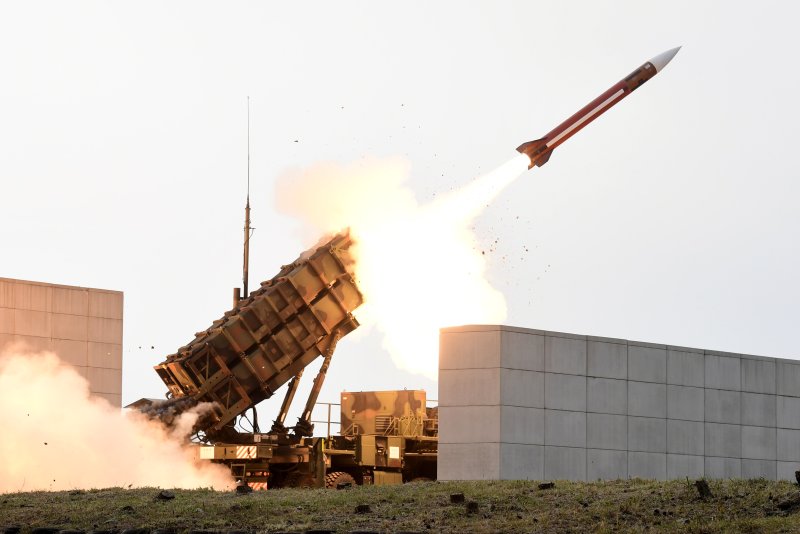A Patriot missile is fired at a shooting range in Daecheon, South Chungcheong Province, South Korea, in November 2017. The Pentagon wants to develop better technology and spend more money to counter threats from China and Russia. File Photo by Yonhap/EPA
April 4 (UPI) -- The U.S. Defense Department is developing technology, including submarine-launched nuclear-tipped cruise missiles, to counter increasing threats from Russia and China, Pentagon officials told a Senate subcommittee.
High-level officials appeared before the Senate Armed Services Committee's strategic forces subcommittee Wednesday to describe the importance of increased defense spending in the Pentagon's budget request for next year.
In March, the Defense Department requested $718.3 billion in a strategy that "fully recognizes that future wars will be waged not just in the air, on the land, and at sea, but also in space and cyberspace, increasing the complexity of warfare. It modernizes capabilities across all warfighting domains to enhance lethality."
Although the spending remains near a record low as a share of the U.S. economy, the spending handles threats posed by China and Russia "through maintaining our competitive advantage."
"In fiscal year 2020, we will continue to build a more lethal and ready Air Force, while fielding tomorrow's Air Force faster and smarter," Secretary of the Air Force Heather Wilson and Air Force Chief of Staff Gen. David L. Goldfein said in a joint posture statement to the committee. The hearing was the third congressional appearance of the week by Wilson and Goldfein.
The independent and bipartisan National Defense Strategy Commission mentioned a vision for building "the Air Force we need."
"Regardless of where the next conflict occurs or which adversary it features, the Air Force will be at the forefront," the Commission said.
John C. Rood, the undersecretary of defense for Policy, described how adversaries are developing sophisticated ballistic and cruise missile systems that include increased speed, range, accuracy and lethality. He noted how an enemy's hypersonic glide vehicle maneuvers outside traditional trajectories, and is more difficult to track and destroy.
The Defense Department wants an improved wide-area surveillance system to defend against cruise missiles. That includes enhancing the Aegis ballistic missile defense system by procuring Standard Missile-3 block IB and Block IIA missiles and integrating the SPY-6 radar as well as additional Terminal High-Altitude Area Defense interceptors, Patriot interceptors and the Army Indirect Fire Protection Capability command and control system.
The Pentagon is specifically requesting money for a low-yield modification to an existing warhead for submarine-launched ballistic missiles and submarine-launched cruise missiles.
Rood mentioned the missile when responding to a question from Sen. Josh Hawley, R-Mo., about the importance of low-yield tactical nuclear weapons to deter threats.
He said the current "sub-launched cruise missile is further behind, and we're just doing an AoA or analysis of alternatives at this stage."
The issue also was brought up at a House committee meeting last week.
Rep. Susan Davis, D-Calif., said she was unconvinced such weapons are needed.
Rood outlined several ways the Pentagon is beefing up it defensive posture. To deter Russia, they include more resources in Alaska: an additional 20 ground-based interceptors to 64, a new missile field at Fort Greely, and new discrimination radars in Alaska as well as Hawaii, and operations extended for the sea-based X-band radar.
To defend against emerging threats, funding is sought for space-based defenses with $143.1 billion requested. That includes additional sensors, integrating kill assessment into the ballistic missile defense system, sustaining a space tracking and surveillance system, near-term sensor and command and control upgrades against hypersonic missiles, tests of SM-3 Black IIA capability against an ICBM-class target, the study of the practicality of interceptors, continued high-energy laser development and kinetic boost phase interceptors using a tactical air platform.
In the budget breakdown, $9.6 billion is requested for cyber; $57.7 billion for air domain; $34.7 billion for maritime domain, including the largest shop building request in 20 years; $14.6 billion for ground systems, $31 billion for multi-domain and nuclear triad and $13.6 billion for missile defense.
In innovation and technology, $3.7 billion is sought for drones, $927 million for artificial intelligence, $2.6 billion for hypersonic weapons development,
The United States is not alone in beefing up defense. Rood said the Pentagon is working with NATO, Spain, Turkey, Romania, Poland, Gulf partners in the Middle East, Israel, Japan and other nations.















